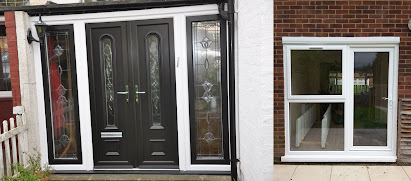Different Types of Windows
All windows let in light, and most provide some ventilation, but windows can differ in several ways beyond those typical functions. It is easier to open certain window styles, some are good for large views, and some are better for airflow. Different windows may also have very different appearances to fit the architectural design or decorative style of a house. Narrowing down the several window choices begins with the identification of one of the basic types of windows.
Casement Windows - Casement windows (like wooden slat windows) often open out and normally pivot from side hinges. In order to provide sufficient light that is uninterrupted by muntin bars or other framings, most casements have fairly large glass panes. Casements often usually have a more transparent ventilation area than other styles of windows. Casement windows can make a very effective seal for enhanced energy efficiency when closed and locked. Like awning windows, casements do not open out into traffic lanes.
Double-Hung and Single-Hung Windows - The most popular and recognisable window styles are double-hung and single-hung windows. The only distinction between them is that a movable lower sash and a fixed upper sash are single-hung, whereas two movable sashes are double-hung; the upper sash slides down. Slightly improved ventilation is the key benefit of double-hung windows. Air naturally flows in through the lower opening and out through the upper opening with both sashes opened around halfway. Double-hung windows can also be washed inside and out without additional washing. In most places, single and double glazed windows work and have a classic decorative look. Usually, they provide less open space than case and slider windows and can be more vulnerable than casements to air leakage.
Sliding Windows - There are two sections of sliding windows that are typically made of single windows, and one of the sections slides horizontally over the other to open or close. Slider windows move sideways to open. They can provide clear views and adequate ventilation, similar to casements windows, but they can not be sealed as tightly as casements.
Thanks to their wide openings and simple operation, sliders are widely used for egress windows in basements or below-grade bedrooms. Utility windows often appear to be sliders at the tops of basement walls. Sliders are very simple, with no mechanical parts and typically quite basic seals and no tensioning mechanism (other than a lock). Sometimes, this simplicity makes them the least costly type of window.
Picture Windows - In areas where airflow is not significant because they do not open, picture windows are best. They are also wide glass expanses occupying the centre portion of a wall to provide broad views and adequate sunlight. For high windows in two-story foyers, picture windows fit well as well. Picture windows are less vulnerable to air leakage than operable windows because they do not open, but their wide glass panes can lose or gain heat (compared to an insulated wall), even with energy-efficient double-pane construction.
Sash Windows - The sash window is a type of casement window, but the panels are completely glazed in this case. It consists of rails at the top, bottom and centre. By means of small timber components called sash bars or glazing bars, the gap between the rails is divided into small panels.
Metal Windows - For making metal windows, usually mild steel is used. These are very inexpensive and have more power. So, these are commonly used nowadays, especially for public buildings, private buildings, etc. Some other metals like aluminium, bronze, stainless steel etc. are used to make windows. Compared with mild steel windows, however, they are expensive. Metal shutters are also installed for standard case windows to give the panels good protection.
Bay Windows - Bay windows are projected wall-form windows that are provided to increase the opening space, allowing more outside ventilation and light shape. There are various shapes for the projection of the bay windows. It can be triangular or polygonal or rectangular, etc. They give the structure a gorgeous look.
Article Source: Different Types of Windows | Imagine Home

Comments
Post a Comment